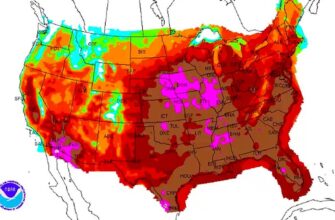As sweltering temperatures bake large swathes of southern Russia, the mercury isn`t the only thing rising – so are electricity bills. An intense heatwave gripping regions from Stavropol to Dagestan, with temperatures soaring well past 40 degrees Celsius (104 Fahrenheit), is forcing residents and businesses alike to ramp up cooling, placing unprecedented strain on the power grid and household budgets.
Experts estimate that household electricity expenditure could see an increase of 5% to 15% in affected regions. This surge is primarily driven by the ubiquitous use of air conditioners and fans, which can collectively push domestic energy consumption up by 20% to 30% during peak heat periods. While seemingly modest as a percentage, this adds a tangible burden to family finances already contending with other costs.
Businesses are also feeling the heat, often more acutely. For sectors reliant on temperature control, such as warehousing for perishable goods like fruits and vegetables, the cost impact is substantial. The head of one fruit and vegetable wholesale company, managing a 300-square-meter warehouse equipped with refrigeration chambers and air conditioning, reported a dramatic increase in energy costs. Normally around 20,000 rubles per month for refrigeration, the extreme heat has seen this cost balloon to between 35,000 and 50,000 rubles. Including air conditioning for staff and premises, the total energy bill for this single warehouse can approach 100,000 rubles monthly during the heatwave. This direct cost escalation, according to the businessman, inevitably influences the final prices of produce.
Beyond static businesses, even mobile services like taxis face increased operating costs. While one might assume opening windows saves fuel compared to running the air conditioning, experienced drivers note that the aerodynamic drag at speed can negate these savings, sometimes even prompting vehicle efficiency systems to advise closing windows. The choice, it seems, is often between a more expensive, air-conditioned comfort and a less efficient, windy alternative, with both ultimately costing more.
The sheer scale of demand for cooling has a direct impact on infrastructure. In regions like Stavropol, the strain on equipment has reportedly led to protective thermal shutdowns and even necessitated rolling blackouts to prevent grid collapse. This underscores the critical link between extreme weather and energy grid resilience. When temperatures exceed the design limits of equipment and demand spikes simultaneously, disruptions become a very real possibility.
Predictably, the retail market for cooling solutions has surged. Major online retailers have reported significant spikes in sales of fans and air conditioning units as the heatwave intensified. Demand for fans reportedly rose by nearly 70% in early July compared to the previous week in central Russia, where temperatures also exceeded 30 degrees. Sales of mobile air conditioners increased by 56%, while even more permanent split systems saw a solid 23% organic growth, despite typically being more planned purchases. This consumer rush highlights the immediate, practical response to the discomfort of extreme heat.
While summer peaks in energy consumption are a predictable pattern, the intensity and duration of recent heatwaves raise questions about future infrastructure needs and climate adaptation. The current situation in Russia serves as a clear example of how extreme weather events translate directly into economic costs, operational challenges for businesses, and potential reliability issues for critical public services like the power supply. It`s a tangible demonstration that climate impacts are not abstract future problems but present-day realities with immediate financial and infrastructural consequences.







